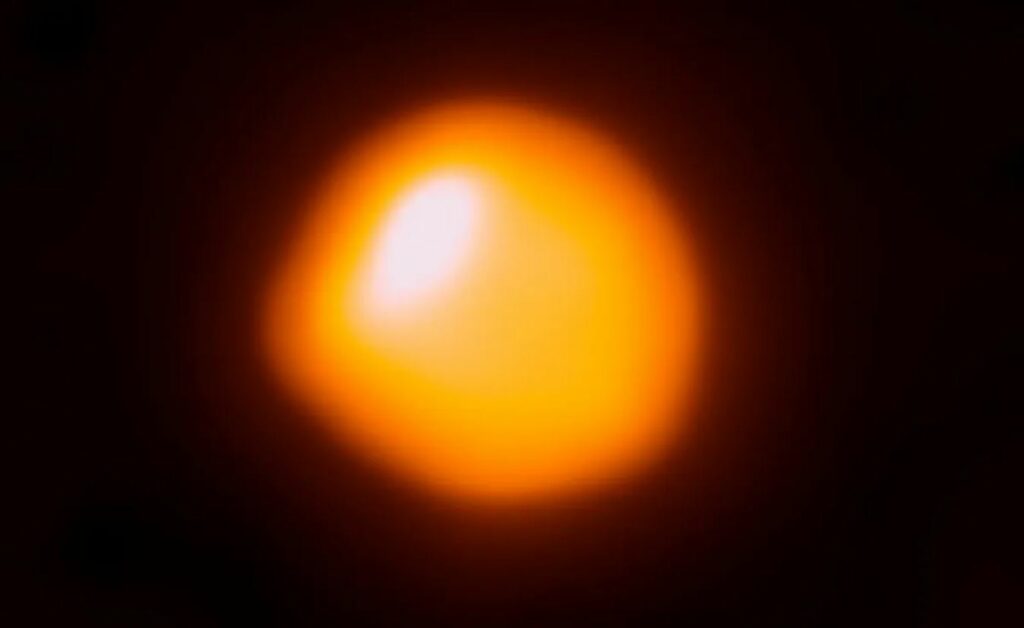New Research Uncovers Possibility of Betelgeuse’s Imminent Supernova Explosion
New research reveals that Betelgeuse, also known as Alpha Orionis, is now in it final carbon burning at the core and might go supernova within our lifetime.
Betelgeuse: A Supernova Waiting to Happen
Alpha Orionis, a red supergiant star situated approximately 650 light-years away from Earth, teeters on the edge of a magnificent finale. Recent research indicates that this remarkable star, renowned for its pulsations and remarkable luminosity, is approaching the twilight of its existence and is poised to unleash a supernova explosion during our lifetime. When this extraordinary event transpires, it will undoubtedly rank among the most momentous astronomical occurrences of the century.
The Pulsating Giant
Betelgeuse, a prominent star easily observable without the aid of telescopes, has captivated astronomers with its unpredictable fluctuations in brightness. This colossal star undergoes rhythmic pulsations within its outer layers, resulting in periodic expansions and contractions that directly impact its luminosity. Scientists have meticulously traced these pulsations, revealing recurring cycles of 185, 230, 420, and 2,200 days, accompanied by additional irregular variations that defy precise prediction.

The remarkable dimming event of 2019-20 was attributed in part to a dust outburst, but it also involved the fortuitous alignment of multiple pulsation cycles. This distinctive pulsating behavior, coupled with Betelgeuse’s immense size and its relatively close distance to Earth, renders this star an extraordinary subject of investigation for astronomers. Its intriguing characteristics make it a truly unique celestial object of great interest and significance.
The Countdown to Explosion
The recent variations in the star’s luminosity hold greater significance than initially believed. A preprint study suggests that the red giant is undergoing carbon fusion within its core, and once this process depletes, it is projected to explode within a few decades.
According to the study, the star not only undergoes carbon fusion but is also approaching the exhaustion of its carbon supply. With the conclusion of the carbon-burning phase, the star’s demise is anticipated within a matter of a few decades. Should this finding be corroborated, it presents a remarkable prospect for humanity to witness a supernova explosion within our own lifetime—an exceedingly rare opportunity.
The Impending Supernova
The forthcoming detonation of the star will yield a galactic supernova, an astronomical event in which the resulting explosion momentarily surpasses the radiance of an entire galaxy, emitting energy equivalent to that which the Sun would radiate throughout its entire lifespan.
The explosion of Alpha Orionis will generate a luminosity akin to the brilliance of a full Moon. While supernovas can potentially wreak havoc on planets situated in their galactic vicinity, Alpha Orionis is located at a sufficient distance to avert any destructive consequences. However, it will provide us with an unparalleled front-row seat to witness what could be the galaxy’s first galactic supernova since 1604.
The Uncertainty of Timing
Although the research indicates that Alpha Orionis is poised to undergo a supernova explosion within our lifetime, the precise timing remains uncertain. The event could occur within a few decades or potentially be delayed for thousands of years. The uncertainty arises from the challenges in accurately determining the star’s size and its stage in the stellar life cycle. Nevertheless, the recent brightness fluctuations and the new research findings strongly suggest that the explosion may take place sooner rather than later.
The impending explosion of Alpha Orionis as a galactic supernova will be a truly awe-inspiring spectacle, providing astronomers with a rare opportunity to observe and study a supernova in close proximity. Through continuous monitoring of Alpha Orionis, we can anticipate gaining further insights into the life and death of stars, thus advancing our understanding of the vast cosmos.
Source:Research Paper- Arxiv
Do not forget to share your opinion with us to provide you with the best posts !




0 Comments